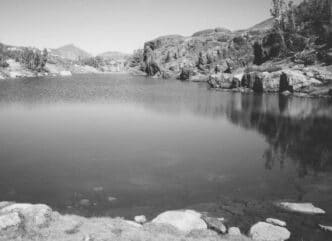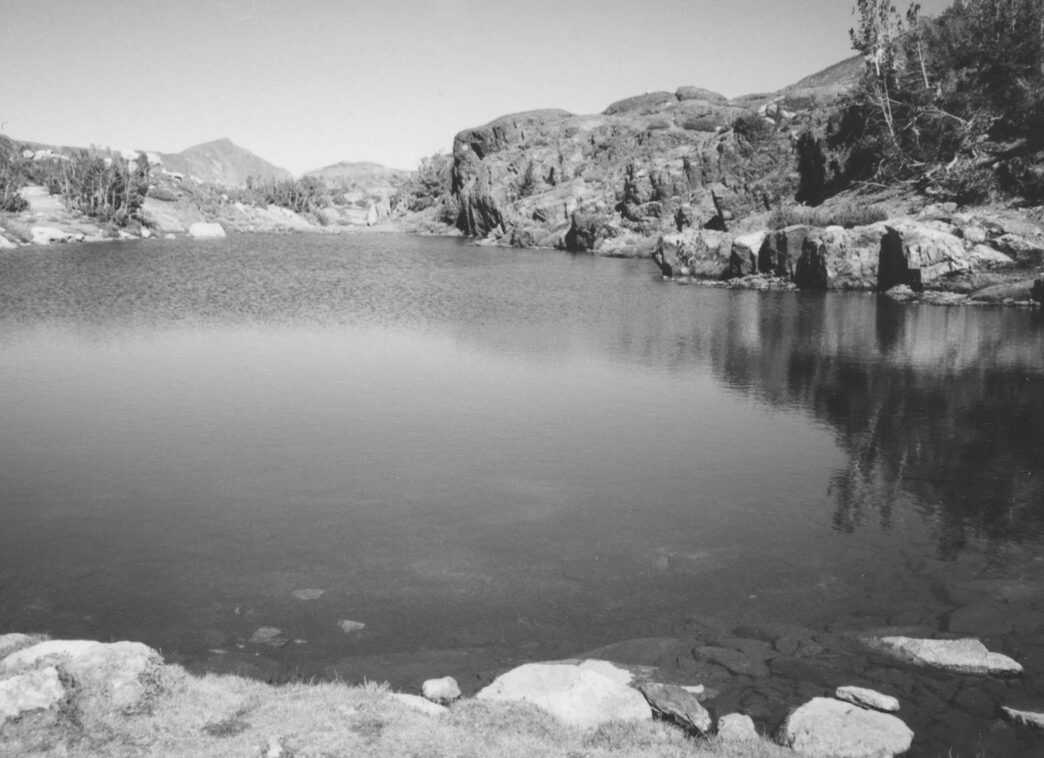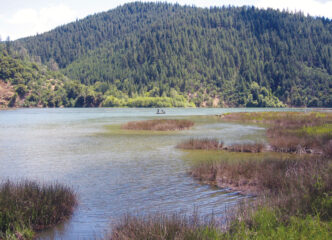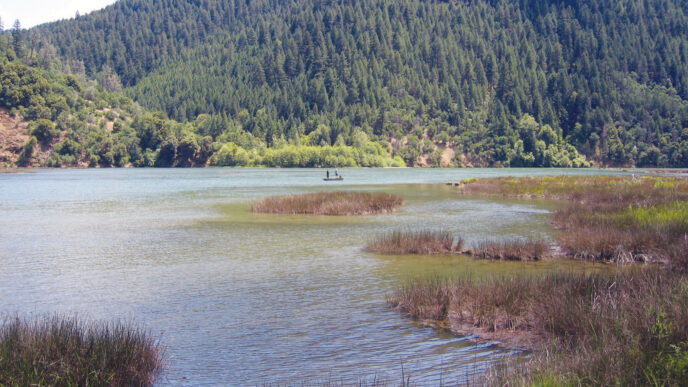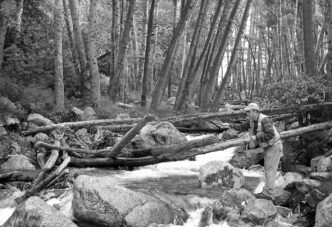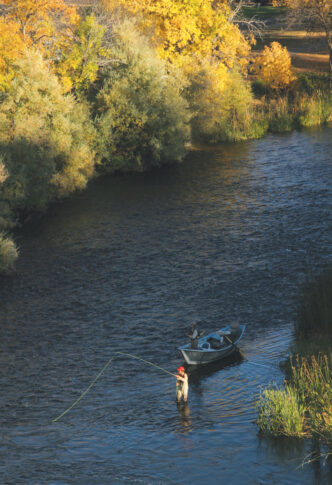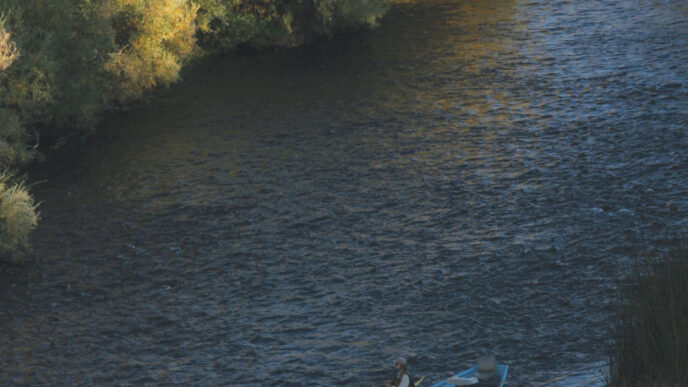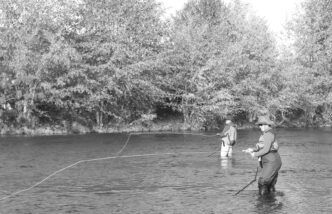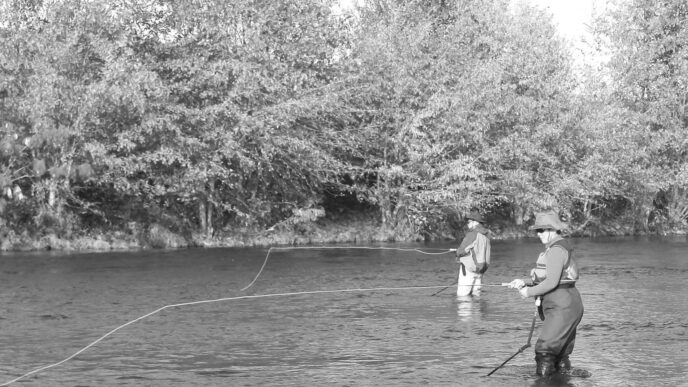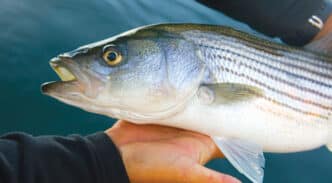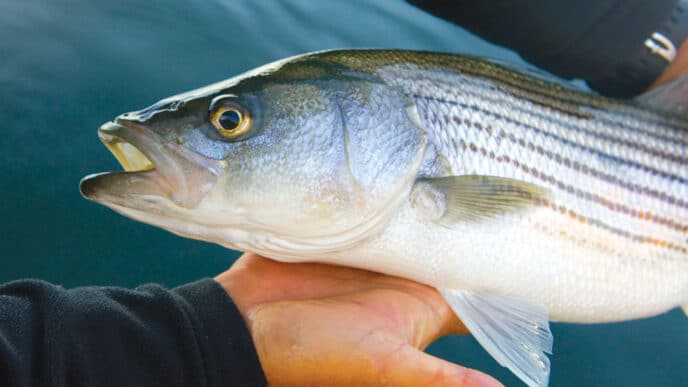High-elevation lakes are different. Compared with lakes at lower altitudes, alpine lakes have colder water, bottoms composed of rock or gravel, rather than sand, mud, or silt, less underwater plant life, and less insect life (which means they’re less fertile), much shorter “growing seasons,” and fewer days available for anglers to fish, due to either ice on the water or too much snow on the ground, preventing you from getting to the lake. Also, the trout in alpine lakes tend to be aggressive feeders and are less likely to be as selective than their brethren living at lower altitudes.
I’m talking about lakes at or above 8,000 feet in elevation, although factors such as exposure, latitude, and microclimates prevent an exact definition of alpine lakes by elevation alone. While people may often think of such lakes as being remote, requiring arduous planning and effort to locate and hike to, in fact, many lakes on the east slope of the Sierra are easily reached from the Highway 395 corridor, with paved and well-maintained roads going west into the higher elevations. Although you can choose to fish a lake that can be reached only by a long uphill trek, a number of alpine lakes (and even subalpine lakes above 6,000 feet) are located off or at the end of roadways that don’t even require a four-wheel-drive vehicle. You can drive right up and begin to fish.
The Character of Alpine Lakes
To fish any lake successfully, you must be aware of a few things. First, regardless of where fish live, they all have the same priorities. They seek shelter and safety from anything that might eat them, they must maintain an adequate nutritional intake, and they require water that has the correct balance of temperature and oxygen. The next thing to remember is that in moving water, the fish wait for their food to come to them, but in still water, the fish must actively seek their food. Also, the saying about moving water, that you never step in the same stream twice, applies to still water, as well: “Still” water nevertheless is dynamic and ever changing, based on changes in temperature, sunlight or cloud cover, wind, clarity, debris, and so on.
Many accomplished stream anglers may feel bewildered when scouting a body of still water, because the location of the trout isn’t advertised by seams, riffles, rocks, pools, runs, or flats.
While an occasional rise will let you know that fish inhabit the lake, determining exactly where they’re holding is more challenging, and you can end up chasing your tail trying to figure out where the next rise will occur. If you’re fishing from a float tube or other small watercraft, you can pick up an occasional stray while randomly trolling. However, the odds of being successful are greatly enhanced if you focus your efforts on the most productive areas of the lake.
Lakes do have specific locations that attract trout, and understanding them while keeping in mind the needs of the fish makes knowing where to place your fly much easier. The places that usually have the most fish are, in no specific order of importance, inlets, outlets, points, dropoffs (also referred to as “shelves” or “ledges”), weed beds, and springs. These spots afford the fish one or more of their three primary needs, and once located, they offer the best opportunity for the most strikes. Another location, which changes with the wind direction, is the leeward or downwind shoreline. Wind also creates foam or scum lines that collect and hold dead insects on the surface. Finally, if you are fishing during ice-out, edges where ice meets the open water are often good locations.
Structure influences the location of trout in alpine lakes, as it does in lower-elevation lakes, too. I think trout probably feel more secure if there is something nearby that offers protection from predators, and structure fulfills that need. Points and drop-offs afford shelter by having deeper water nearby to which fish can retreat if they feel threatened. In alpine lakes, look for additional structure in the form of fallen trees and rocks protruding above the surface. You will frequently find trout cruising in their vicinity.
Alpine lakes, as opposed to warmwater lakes, often present less difficulty in determining the location of the most productive spots, because they usually have relatively clear water and can be shallower. Also, lakes at higher elevations are frequently located in bowls or cirques, and you can observe them from above, which allows you to spot many of the prime places that otherwise might remain undetected from lake level. Polarized sunglasses are a valuable asset when attempting to look beneath the surface. You might also consider carrying a pair of lightweight binoculars to assist you in assessing the lake from farther away. In addition to spotting holding areas, you might also see rises and even insects, and observing from a distance could avoid spooking fish that are cruising or hanging out in the shallows near the shoreline.
Flies for Alpine Lakes
Fly selection for the Sierra’s alpine lakes is not overly difficult. Because high lakes are typically not as nutrient rich and fertile as lakes lower down, food is often less plentiful, and the trout become opportunistic feeders, usually going after a variety of bugs, as opposed to being excessively selective. This is good, because it allows us to present impressionistic patterns, rather than having to match the hatch with more exact imitations. Even when no insect activity is visible and no fish are observed rising, a small dry fly will often produce an enthusiastic strike. I’ve discovered a couple of general trends regarding flies that have increased my success in alpine lakes. One is that if the fly you’re presenting doesn’t solicit a response, try using the same pattern in a smaller size. Still water affords trout the opportunity to study your offerings somewhat longer than moving water does. Smaller patterns apparently camouflage subtle flaws in construction, proportion, or materials. If that doesn’t work, substitute the same thing in a darker color. Again, I don’t know why, but it seems that darker colors also hide things that may cause fish to reject your presentations.
Generally speaking, the dries and nymphs you use in moving water and at lower-elevation lakes also work fine in alpine lakes. Just be sure you have a wide range of sizes and colors. Some specific patterns, in addition to the usual suspects, should include “fore-and-aft” flies such as the Renegade or the Sierra Bright Dot for your dry-fly box, while Andy Burk’s BugEye Damsel and Water Boatman patterns should be present with your nymphs. Also, be sure not to forget soft hackles, which imitate nymphs and emergers, and remember that scuds are often found in alpine waters.
My streamer patterns are fairly sparse ties. I carry Woolly Buggers in black, olive, and brown in sizes 8 to 12. I’ve also had success with Woolly Worms in the same colors and sizes. In addition, I carry Light and Dark Spruce Flies and Matukas in black, olive, and brown in sizes 6 and 8.
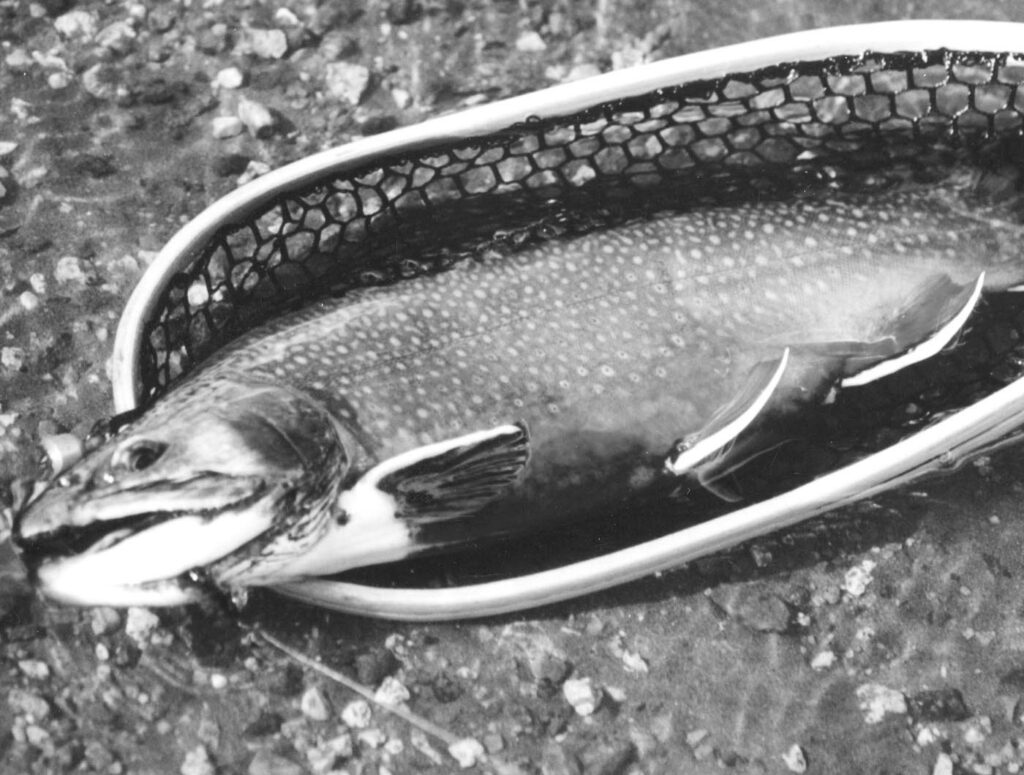
Another thing to keep in mind is that chironomids (midges) are usually the most abundant food source in alpine lakes. It’s prudent to carry patterns in a variety of sizes and colors that match the various stages of their life cycle. To insure that you are prepared for any situation you encounter, it’s necessary to have patterns from sizes 12 or 14 down to 22 or 24 in colors from black to cream. Midge pupas with metal or glass bead heads are a must, and Brassies in the same sizes work well. You may even wish to dedicate one small fly box to hold your midge patterns.
Griffith’s Gnats from size 18 to 24 are a great generic midge pattern for the surface. In Fishing the Midge, Ed Koch describes a simple pattern that consists of a hackle-fiber tail, a tapered thread or dubbed body, and a hackle matching the body color or a grizzly hackle. He calls this pattern the Black (or appropriate color) Midge. It works very well, and I carry sizes 16 to 24.
Last, but certainly not least, there are the terrestrial patterns. In Fly Fishing the Mountain Lakes, Gary LaFontaine wrote “The most important class of dry fly for mountain lakes is the terrestrial imitation. The trout, feeding on blow-ins day after day in the summer, look for ants, beetles, bees, and spiders. The image of drowned fare floating awash on the surface gets imprinted in their minds.” I couldn’t agree more. While I’ve never tried bees or spiders, I’ve had tremendous results with ants and beetles. I tie fur-bodied black ants in sizes 12 to 18 and black beetles in sizes 12 to 16. I have ants in other colors, mainly red and cinnamon, and beetles in tan, but they never seem to get wet. Black is so well received that there’s no reason to change. My friend Mike told me that when he had his little shop in Bridgeport, he offered a money-back guarantee if any of his customers purchased a black beetle and didn’t catch trout on it if the lake was at an elevation above 9,000 feet. He never had to return the money. Stimulators in size 12 and Madame Xs in size 10 round out my terrestrial patterns.
Gear for Alpine Lakes
In my opinion, you don’t need a specialized rod, reel, and line combination to fish alpine lakes in the Sierra successfully. Any rod from a 4-weight to a 6-weight, 8 to 9 feet long, will perform quite well. I always carry two rods. Most often, one is a 4-weight with a moderate flex, and the other is a 6-weight that has a faster or stiffer action. Between the two, I can usually cover whatever conditions of wind, distance, and type of cast I encounter when trying to get the fly to the fish. It’s always wonderful, but very rare, to hook a fish large enough to have to play it from the reel, so I focus on a reel that is light in weight and a good balance for my rod. Although nice to have, a disk drag really isn’t necessary, adding only weight and expense. A weight-forward floating line will take care of 90 percent of your needs, and a sink-tip or clear intermediate line will get you into deeper water if you need to go there. I therefore would recommend carrying a couple of extra spools loaded with different lines for various conditions. Although trout living in high-elevation lakes can be aggressive feeders, they also tend to spook easily, so longer leaders and tippets are often necessary. I generally start with a 9-foot 3X tapered leader and add tippets of 3 to 6 feet from 3X to 6X, matching the tippet to the size of the fly. On some size 22 or 24 flies, you might have to go down to 7X to get the tippet through the eye. The net result is that you’re casting a leader system of 9 to 15 feet most of the time.
I have mixed feelings about fluorocarbon given the long time it takes to degrade in the environment. However, some friends have told me that it has made quite a difference for them. I suppose it wouldn’t hurt to try it if all your other efforts have not yielded success.
Tactics for Alpine Lakes
Once you’ve decided where you want to fish, approach the location cautiously. Utilize trees or brush, small mounds or other terrain features, and boulders or rocks to prevent the trout from seeing you approach. All trout can be frightened by sudden movements, bright clothing, and vibrations from a heavy footstep, so it does not hurt to be stealthy. A common error is walking directly to the shoreline when preparing to fish from that spot. If you begin casting to the water near the shoreline from a short distance back, you’ll have a better chance of hooking any fish holding there. If you get no strikes, move closer and cast farther out from the shore, continuing to do so until you reach the water.
The shallower water near the shoreline often attracts the most fish for a number of reasons. Usually, plant life is located in the shallows, because the sunlight penetrates better, and plants are where insects thrive, attracting the trout. Also, shallow water is warmer than the deeper water farther from the shoreline, and at high altitudes, trout feed more actively in warmer water. When the wind pushes surface debris, including dead insects, across the water, it stops at the weed beds in shallow water or at the shoreline. Finally, it’s easier to see the fish in shallow water, and that provides you with an advantage when targeting a specific fish.
If I can’t see any trout, and there aren’t any rises, I often start by casting a small dry fly, usually an ant or beetle. I usually don’t put floatant on it unless I’m actually casting to rising fish, because actual ants and beetles will slowly sink beneath the surface if blown onto the water. When you’re standing on the leeward shore, the wind and moving water will move your line toward you, so your retrieve consists of slowly pulling the line in just fast enough to keep it taut. Cast near structure and edges, and try not to move your offering too quickly. If that doesn’t entice a fish to strike, I switch to a nymph pattern, usually a Gold-Ribbed Hare’s Ear, Zug Bug, or Prince Nymph, and cast near structure or into cruising areas. I find the most success when keeping the fly down near the bottom and retrieving slowly, with either a hand-twist retrieve or slow, short jerks with lots of pauses.
Regarding retrieving speed, if your usual retrieve isn’t getting results, try slowing down. Most of us tend to retrieve far too quickly and would have more success with a slower approach. Mike once told me that in alpine lakes, your retrieve should be so slow that you need to be concerned with keeping rust off your hooks. I think he’s probably correct. With some few exceptions, subsurface insects tend to move slowly, and you need to mimic their movement if you hope to hook more fish. Also, slow retrieves keep the fly lower in the water column, and that’s frequently where the trout are looking for food.
When fishing streamer patterns, vary your retrieve to imitate small baitfish or fry. Sometimes casting as far as you can and stripping the fly in as fast as possible may work well, while under other circumstances, a few quick strips, followed by a short pause, seems to be the ticket. On other occasions, a slow retrieve with the fly deep near the bottom will produce the best results. The goal is to make your streamer appear alive and vulnerable to the trout.
Another favorite technique of mine is to fish a two-fly rig. I use a fairly large dry fly (usually a size 12 Royal Wulff, Stimulator, or Madame X) as both an attractor and a strike indicator and tie a small midge pupa or Brassie on a dropper between three and five feet long that is tied to the bend of the hook. I usually reduce the dropper tippet size by one X. This approach often works best when there’s a slight chop on the surface. I think the fish feel safer in coming to the top, and the chop also provides an up-and-down movement to the dropper fly, mimicking a natural that is trying to move up to the surface to emerge. Toss the flies to likely holding spots, then retrieve the line just enough to keep it taut. If there’s a rise in the vicinity, I often pull the rig out of the water and cast near the rise. If there’s no strike then, I revert back to just keeping the line tight.
One of the largest rainbows I’ve ever landed at an alpine lake succumbed to that two-fly combination. I was standing on a rocky point and casting into the wind, with browns running from 12 to 14 inches taking the dropper. As they hit, the Royal Wulff was pulled beneath the surface, and I’d set the hook. I was preparing to cast out again and had retrieved the fly to within 12 or 15 feet of the shore when I saw the indicator disappear beneath the surface. Thinking it was another brown, I set the hook and began to strip in the line. My rod bowed deeply, and the line fled away rapidly through my fingers.
The fish took me into the backing on its first run and almost that far on the next. After the third run, I was able to get the fish to shore and saw that instead of a brown, it was a large rainbow, about 22 to 23 inches long and beautifully proportioned. I estimated its weight at over four pounds. The fish had taken the Royal Wulff. It must have just sucked it down, because there wasn’t any surface disturbance when the fly went under.
Other Considerations
An additional consideration for alpine lakes whether to use of a float tube or other small watercraft. If you’re fishing a lake that you can drive to, bringing a float tube, pontoon boat, pram, or small fishing boat isn’t usually a problem. Not only can you cover more water than from shore, you can find prime areas that are too far from the shoreline to reach, even with your best cast. Also, many lakes at higher elevations are surrounded by trees or steep terrain, both of which interfere with a back cast. If you have to hike into an alpine lake, however, the extra weight and bulk of the tube, waders, fins, and ancillary equipment may or may not be worth the effort — only you can decide.
The weather in the Sierra is often very volatile and can turn from pleasant to downright nasty in just a few minutes. During the summer months, afternoon thunderstorms can happen almost daily, and lightning is dangerous. It seems that the higher up you go, the harsher the weather can get, so be diligent in monitoring the conditions and be prepared to stop fishing and seek shelter when faced with an oncoming storm. At drive-to lakes, you can simply retreat to your vehicle. At hike in lakes, carry enough appropriate clothing to enable you to stay warm and dry. The good news is that these afternoon interruptions are usually of short duration, and you can resume fishing when they pass. If you haven’t fished alpine lakes in the Sierra, I hope you’ll consider doing so. High-elevation lakes may be different, but they are not all that difficult to access or to fish successfully, and you probably already have the necessary gear to do so.



